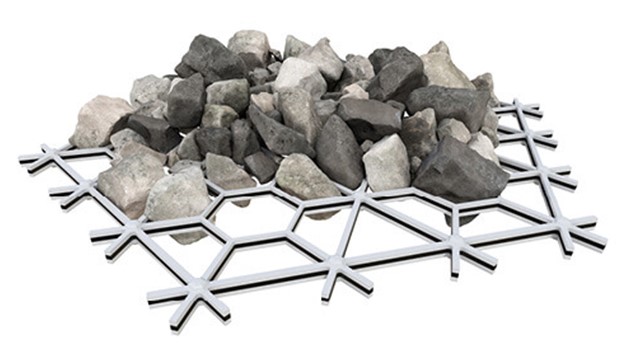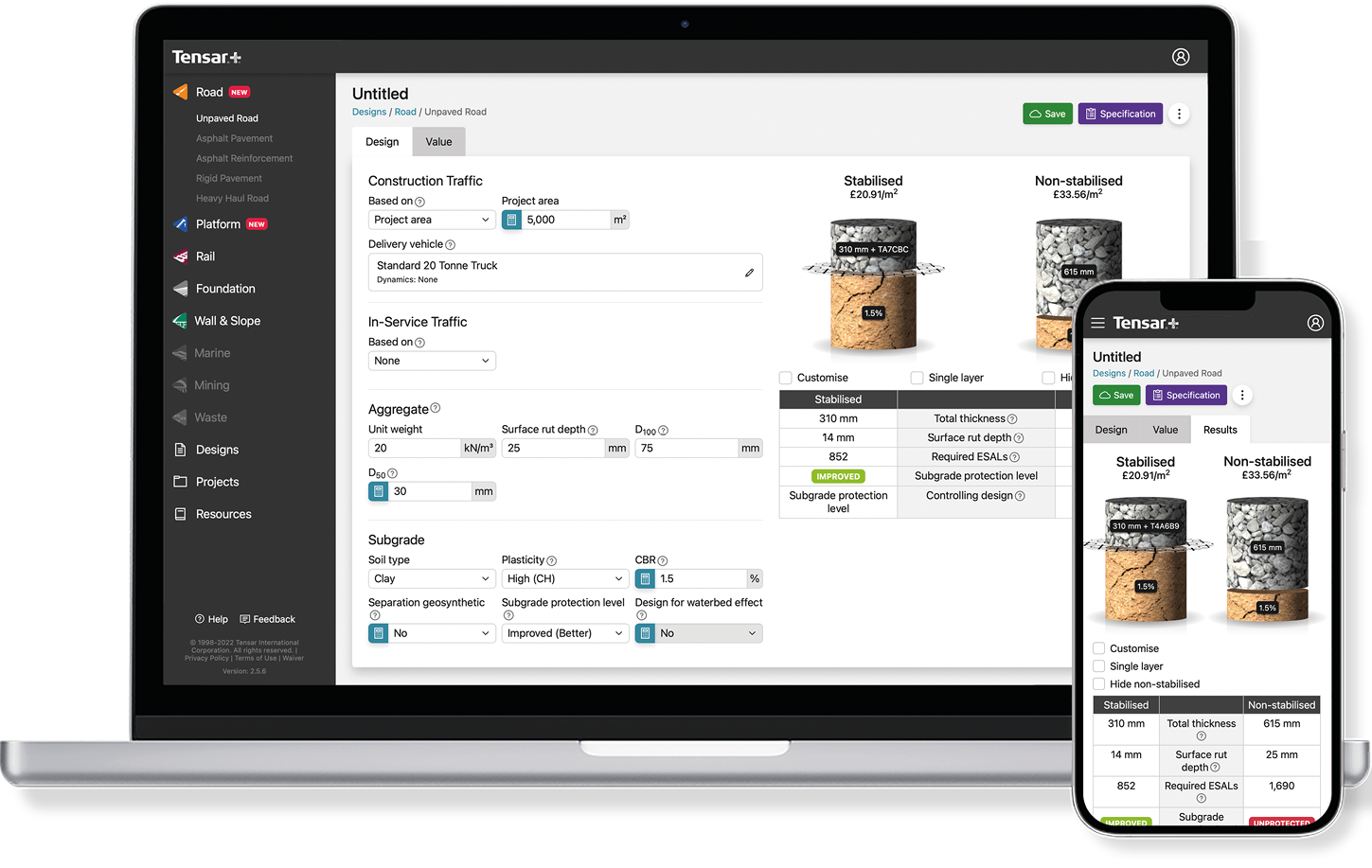Full scale platform design method verification with Tensar InterAx
by Andrew Lees, on July 23, 2024
Back to Saskatchewan for full scale platform testing with Tensar InterAx
The T-Value Method for the design of working platforms has proven to be robust and safe. It enables engineers to design mechanically stabilised platforms that are lower in cost due to the large savings in the volume of fill required, compared to other methods.
The T-Value Method relies on testing to develop relevent parameters. For mechanically stabilised layers (see below), the derived parameters are specific to the combination of fill material and geogrid product used. Tensar has placed great emphasis on the need to validate the method using full-scale testing. The University of Saskatchewan carried out large-scale tests using Tensar TriAx geogrid products prior to its initial release in 2007. Following the launch of Tensar InterAx geogrid, Tensar returned to Saskatchewan in 2022 for further validation using this Next Generation geogrid.
Andrew Lees talks about full scale platform design method verification conducted by the University of Saskatchewan which shows the test taken to failure.
Why was a working platform design tested at Saskatchewan?
Working platforms must be designed to carry the large loads applied from tracks or outriggers with a defined factor of safety against failure. The T-Value method allows designers to calculate the ultimate bearing capacity to which a suitable safety factor against failure is applied.
The only way to truly validate any platform design method is to conduct full-scale plate load testing – to failure. This requires a massive test rig and a large area for multiple tests. The University of Saskatchewan has developed unique expertise and equipment for this type of testing.
What testing was conducted to validate the working platform design?
Full-scale plate load tests were conducted on test sections constructed over a clay subgrade. Some sections incorporated Tensar InterAx geogrid, which enabled comparisons to be made with non-stabilised sections.
A 1m square plate was used, rather than the 0.3m or 0.6m diameter circular plate more commonly used for this type of test. This was important to create a pressure bulb below the plate similar in size and depth to that created by the track of a piling rig or the outrigger of a large crane operating on a working platform.
The applied load, settlement of the plate, and the surface movements surrounding the plate, were monitored, and recorded.
Moisture content of the clay subgrade was monitored and adjusted to maintain consistency in shear strength, this was checked by both CPT and shear vane testing throughout the test period.
Unusually for this type of test, the loading was applied until bearing failure of the platform. This required a sturdy reaction frame with kentledge weights to apply the enormous load needed to fail the platform.
Why test to failure?
Plate load tests in the field are rarely taken to failure as this requires a high load that is difficult to apply. The Tensar test programme at Saskatchewan, with its large reaction frame and kentledge weights, was designed to allow the plate load tests to continue to failure. This was important to fully validate the T-Value method and the parameters used for the mechanically stabilised aggregate layer incorporating Tensar InterAx geogrid.
Further validation testing at National Buried Infrastructure Facility (NBIF)
As part of the continuing programme of research carried out by Tensar, further validation of the T-Value method and Tensar InterAx geogrid has been undertaken at a unique test facility at the University of Birmingham NBIF in the UK. The facility has a 25m x 10m x 5m deep test pit with a heavy-duty reaction frame suitable for large scale plate load testing. For the Tensar tests, a 1.0m x 2.0m size plate was used to simulate loading from the track of a piling rig or crawler crane.
This test programme will be the subject of a future Tensar Ground Coffee blog. In the meantime, you can read more about the test here in the Informaton Bulletin - Working Platforms Over Granular Subgrades and Ground Engineering online.
What is the T-Value Method?
Tensar’s T-Value Method for working platforms is based on the relationship between the bearing capacity and the load transfer efficiency of a granular layer expressed as a T-Value. The method allows accurate assessment of the benefit of incorporating one or more layers of a stabilising geogrid into the granular layer.
The T-Value for a specific combination of geogrid grade and granular fill type can be derived from testing. This then becomes an input to the design method.
The T-Value method has been welcomed by the industry. Since its introduction in 2019, the method has been widely used for the design of working platforms around the world.
A more detailed explanation of Tensar’s T-Value Method for working platform design can be found here.
T-Value Guide: A new direction for temporary works design.
What is a mechanically stabilised layer?
When a geogrid is incorporated into a granular material, the granular particles interlock with the geogrid. Provided the geogrid has adequate in-plane stiffness and suitably strong junctions, the granular particles are confined within the geogrid apertures. Confinement restricts movement and rotation of the particles in direct contact with the geogrid, and these in turn confine the adjacent particles with which they interlock. This creates a zone of confinement extending some way above and below the geogrid. This mechanical stabilisation increases the strength and stiffness of the granular layer. Tensar geogrids have been engineered to maximise the magnitude and extent of the confined zone. This increases the stabilisation effect and optimises the load transfer efficiency (T-Value) of the stabilised layer.
.jpg)
Mechanically stabilised layer incorporating Tensar InterAx geogrid.
How you can use the T-Value method to save cost on your next platform project?
Tensar has incorporated a T-Value module into its Tensar+ design software. The module allows the user to design working platforms for tracked plant or the outriggers from mobile cranes.
If you would like to access Tensar+ software to help save time, cost and carbon on your next construction project, register now at:
Tensar+ | A Better Way to Build™ (tensarplus.com)
.png)



-(1).png?width=400&height=400&ext=.png)